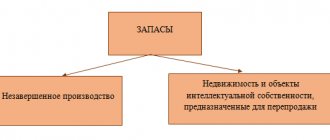Account 66 in accounting
Subaccounts of the account “Settlements for short-term loans and borrowings” are presented below in the figure:
This accounting account is passive, so its increase is reflected as a credit, and its decrease is recorded as a debit. In other words, the debit of the account reflects the repayment of loans and borrowings, and the credit reflects their receipt. The loan balance of account 66 shows the balance of the debt.
Analytical accounting for account 66 is carried out by type:
- Credits and borrowings (separate bills);
- Credit organizations, including those engaged in discounting (discounting) bills or other debt obligations;
- To other lenders who provided credit or loans (drawers).
The amounts of accrued interest are accounted for separately.
Settlements on transactions (discount) of bills of exchange with an organization within a group of interconnected companies, about the activities of which consolidated financial statements are formed, are carried out separately.
A bank loan has been credited to the current account
If we take the time frame as a starting point, then a loan issued by a bank can be short-term or long-term. First of all, let's consider the procedure in which the bank transfers a short-term loan to an account. Loans are considered such if they are provided to the recipient for a period of up to one year.
The need for such loans for clients is dictated by the need to carry out current payments. For example, if you need to urgently ship goods. That is, in essence, such a loan increases the volume of working capital of an individual or legal entity for the current period.
Let's consider how short-term loans are accounted for on the balance sheet of an enterprise. It must be carried out on account 66. And also use subaccounts 01 and 02. The first reflects short-term loans, and the second - interest on them.
If a short-term bank loan was credited to the organization's account, then the following entry is drawn up: Credit account. 66 Debit account 51. If, on the contrary, an enterprise withdraws funds as a payment to repay a short-term loan, then the posting will be as follows: Credit account. 51 Debit account 66.
According to the rules, a long-term loan is one that is provided to the client for a period of more than one year. When keeping records for them, entries are made in a separate account 67.
If such a loan was transferred to the account of an organization or individual entrepreneur, it is necessary to make the following entry: Credit account. 67 Debit account 51. Payment of interest on long-term loans is reflected in the Credit account. 51 Debit account. 67. The entry is made on account 91. By the way, the payment of interest on short-term loans should be recorded in the same way in the reporting.
But interest isn't everything. Additional expenses may be incurred for loans received:
- Funds that will be required to service the movement of the received loan. For example, in some cases you will have to pay a loan fee.
- The funds that an organization needs to spend to obtain consulting and information services.
- Other expenses.
Depending on the type of loan, funds must be credited within their due dates
For such expenses, the following double postings are provided. If settlements are made with suppliers and contractors, then this movement is reflected on the Credit account. 60 Debit account. 90. For settlements with debtors and creditors: Credit account. 76 Debit account 90.
Typical entries for short-term loans and borrowings
Correspondence 66 accounts and the main accounting entries for the account are formed in the table:
| Account Dt | Kt account | Wiring Description |
| 50/51/52/55 | 66 | Receipt of short-term loans and borrowings. Repayment – reverse postings. |
| 7/10/11/41 | 66 | Receipt of commodity credit by material resources of an agricultural organization |
| 62 | 90 | Repayment of a trade loan by shipment of finished products and animals |
| 51 | 86 | Crediting subsidies for interest payments by agricultural organizations |
| 51 | 66.05 | Placement of bonds at par value |
| 51 | 66.06 | Accounting (discount) of bills (face value) by the bill holder |
| 51 | 98 | The difference between the issued and par value of bonds |
| 91 | 98 | Write-off of the difference during the bond's circulation period |
| 91 | 66 | Interest on received loans and borrowings is reflected |
| 91 | 66 | Positive exchange rate difference in foreign currency Negative – reverse posting. |
Valuation of materials in accounting upon receipt
When receiving materials, you need to decide on three points:
- With a choice of subaccount. The subaccount is determined by the type of materials received;
- To evaluate the received values, that is, to understand at what cost, in accordance with the norms of accounting legislation, they should be registered; clause 5 of PBU 5/01 offers 2 ways;
- The chosen method is fixed in the Accounting Policy.
The legislation operates with the concept of “actual cost”. In short, this is what it cost the company to purchase or receive materials.
Important! Materials are accepted for accounting at actual cost. This rule always applies!
The legislation provides 2 options for reflecting the actual cost:
- The first reflection option is that the actual cost is formed on account 10. The subaccount is determined by the type of materials received. This can be represented schematically as follows:
- The second option for reflection is that the actual cost is formed on account 15. Schematically it looks like this:
In this case, the company will use 3 accounts for received inventory items:
- Account 10 “Materials”;
- Account 15 “Procurement and acquisition of material assets”;
- Account 16 “Deviation in the cost of material assets.”
In addition, for account 15 you will need to open sub-accounts with names similar to the sub-accounts that make up the synthetic account 10. This option reads: “Materials are accounted for at accounting (planned) prices using accounts 15 “Procurement and acquisition of material assets” and 16 “Variation in cost material values." Open subaccounts for account 15 will sound similar to the subaccounts for account 10. For example, subaccount 15.1 “Procurement and acquisition of raw materials and supplies.”
The choice of method for reflecting the actual cost is fixed in the Accounting Policy.
What is recognized as actual cost
It is important to correctly reflect the actual cost. Depending on the method of receipt, the actual cost will be formed differently:
In practice, the arrival of materials at the warehouse has two scenarios:
In this article, we will only consider admission based on documents.
Postings for typical situations of acquisition and receipt of materials
Example 1
Consider purchasing materials for a fee. Accounting policy option: the actual cost of materials is formed on account 10:
The company purchased the raw materials necessary to manufacture the products. The cost of raw materials according to the supplier’s documents is 118,000 rubles, including VAT 18,000 rubles. The cost of delivery according to the documents of the transport company is 12,500 rubles, excluding VAT. The warehouseman received these raw materials into the warehouse. The supplier and transport company invoices have been paid.
Additional information: the company does not belong to the small category and applies the general taxation regime. According to the accounting policy, the actual cost of materials is formed on account 10 “Materials”.
Solution. From the summary table above we see that the norms of accounting legislation recognize the actual cost of materials purchased for a fee as the amount of the organization’s actual costs for the acquisition, excluding VAT and other refundable taxes, that is, the actual cost of such materials includes: the contract price of the supplier and other costs directly related to the acquisition of materials (transport, procurement costs to bring materials to a state in which they are suitable for use for the purposes envisaged by the organization).
In our example, the actual cost of raw materials purchased for a fee is the sum of the supplier’s price and delivery costs. Based on the type of materials, we use subaccount 10.01 “Raw materials and materials”.
We generate accounting entries for the receipt of materials at the warehouse:
| Debit | Credit | Amount, rub. | Facts of economic life |
| 10.01 | 60.01 | 100 000 | The receipt of raw materials is reflected based on settlement documents |
| 19.03 | 60.01 | 18 000 | Input VAT on the cost of raw materials is taken into account |
| 68.02 | 19.03 | 18 000 | VAT deduction accepted, conditions under Article 172 of the Tax Code of the Russian Federation are met |
| 10.01 | 60.01 | 12 500 | Delivery costs are included in the actual cost of raw materials |
| 60.01 | 51 | 118 000 | Payment has been made to the supplier of raw materials |
| 60.01 | 51 | 12 500 | Payment has been made to the transport company |
Example 2
Let's study the purchase of materials for a fee. Accounting policy option: the actual cost of materials is formed on account 15 using account 16, that is, on account 10 materials are accounted for at planned prices.
The company purchased the raw materials necessary to manufacture the products. The cost of raw materials according to the supplier’s documents is 118,000 rubles, including VAT 18,000 rubles. The cost of delivery according to the documents of the transport company is 12,500 rubles, excluding VAT. The accounting cost (planned and estimated) of the received raw materials is 107,500 rubles. The warehouseman received these raw materials into the warehouse. The supplier and transport company invoices have been paid.
Additional Information. The company does not belong to the small category and applies the general taxation regime. The newly formed company has been operating for the first month and has supplied raw materials for production in the amount of 50,000 rubles.
Solution. To solve this, you will need to determine the average percentage of deviations of the actual cost from the planned cost and the amount of deviations to be written off from account 16. Let's consider the nuances of working with accounts 15 and 16 when receiving materials.
In the debit of account 15, on the basis of settlement documents (invoices, invoices, acts), the cost of materials, delivery costs, procurement costs and costs of bringing materials to a state in which they are suitable for use for the purposes envisaged by the organization are recorded. With this option, materials are credited to account 10 at the planned price (predicted) and only when the materials arrive at the warehouse, they are received by posting to the debit of account 10 and the credit of account 15 - for an amount equal to the planned price of the materials. Planned prices are fixed by an internal company document.
When the company uses registered materials or transfers them into production or sells them, the difference accumulated on account 16 between the actual cost and the planned price must be written off as expenses. To do this, do the wiring:
- Dt 20 (23, 25, 26, 29, 44 ...) Kt 16 - the accumulated positive difference between the actual cost and the planned price is written off.
To determine how much of the difference listed on account 16 should be included in costs, it is necessary to calculate the average percentage of deviations. It is determined using a complex formula and is not for beginners. But to understand the essence, let’s assume that the company is new, then based on the results of the first month of work, the accountant will take two indicators:
- The amount of deviations for materials received during the month;
- Cost of materials received per month (in planned prices).
Divide the first indicator by the second and find out the average percentage. The average percentage of deviations is multiplied by the accounting value of the materials being written off.
Let's determine the average percentage of deviations in our example:
- Average percentage of deviations: 5,000 / 107,500 = 4.65;
- If the accounting value of the materials written off is 50,000 rubles. multiply by 4.65%, we get the amount of deviations to be written off as expenses in the amount of 2,325 rubles.
Now you have everything you need according to the method of working with counts 15 and 16 when receiving materials. We create accounting entries:
| Debit | Credit | Amount, rub. | Facts of economic life |
| 15.01 | 60.01 | 100 000 | The receipt of raw materials is reflected based on settlement documents |
| 19.03 | 60.01 | 18 000 | Input VAT on the cost of raw materials is taken into account |
| 68.2 | 19.03 | 18 000 | VAT deduction accepted, conditions under Article 172 of the Tax Code of the Russian Federation are met |
| 15.01 | 60.01 | 12 500 | Delivery costs are included in the actual cost of raw materials |
| 10.01 | 15.01 | 107 500 | Raw materials were capitalized to the warehouse at the planned price |
| 16 | 15.01 | 5 000 | The excess of the actual cost over the book price is reflected |
| 60.01 | 51 | 118 000 | Payment has been made to the supplier of raw materials |
| 60.01 | 51 | 12 500 | Payment has been made to the transport company |
| 20 | 10.01 | 5 0000 | Raw materials transferred to production |
| D20 | K16 | 2 325 | The accumulated positive difference between the actual cost and the planned price is written off |
Example 3. Receipt of materials on account of the contribution to the authorized capital.
The actual cost of materials contributed to the contribution to the authorized capital of the company is determined based on the monetary value agreed upon with the founders, unless otherwise provided by law.
If the expenses are borne by the receiving party, then the actual cost of materials increases by the amount of expenses incurred (clause 65 of the Guidelines for accounting for inventories).
Let's say 08/30/2016. As a contribution to the authorized capital of the enterprise, the founder contributed materials that were valued by the founders in the amount of 10,000 rubles. For the delivery of materials, the organization paid the transport company 2,950 rubles, including VAT of 450 rubles. The transferring party provided the acceptance certificate and invoice.
Additional Information. The company is formed as an LLC and applies the general taxation regime - OSNO. The company is a small business. Type of materials - production equipment. In its accounting policies it recorded the following:
- Accounting is carried out at actual cost and is reflected in accounting on account 10.
- Transportation and procurement costs are included in the actual cost on account 10.
Example solution. The transferring party took advantage of the so-called VAT recovery mechanism. Being a VAT payer, in connection with the disposal of materials, the VAT company restored and provided an invoice. Thus, the transferring party increased its obligations to the budget. Why is that?
The fact is that earlier, when these materials were purchased, the organization took advantage of the VAT deduction by posting Dt 68.02 (VAT) Kt 19, but the materials ceased to be used by the transferring party in activities subject to VAT. In such cases, the transferring party in its accounting is obliged to make a reverse entry Dt 19 Kt 68.02 (VAT) - this is called the VAT recovery mechanism.
Since the transferring party transferred the materials with VAT, having previously shown an increase in its obligations to the budget in terms of VAT, the receiving company is obliged to register the presented VAT on the basis of an invoice.
The enterprise is classified as small, but according to the conditions of the example, the Accounting Policy does not include a simplified method for estimating the initial cost. This right exists in accordance with the order of the Ministry of Finance of the Russian Federation dated May 16, 2016. No. 64n. But even if this were recorded, the company would not be able to attribute delivery costs to expenses, since this innovation according to PBU 5/01 applies only to materials purchased for a fee. In the example presented, inventory items were received without payment.
We generate accounting entries for the receipt of materials on account of the contribution to the authorized capital:
| Debit | Credit | Amount, rub. | Facts of economic life |
| 10.09 | 75 | 10 000 | Receipt of materials under the constituent agreement in the assessment agreed upon by the founders |
| 10.09 | 60.01 | 2 500 | Clarification of the actual cost of materials for the delivery amount (clause 65 of the Guidelines for accounting for inventories) |
| 19.03 | 60.01 | 450 | The submitted VAT on transport services on the invoice is taken into account |
| 68.02 | 19.03 | 450 | VAT is accepted for deduction if all conditions under clause 2 of Article 171, clause 1 of Article 172 of the Tax Code of the Russian Federation are met |
| 19.03 | 83 | 1 800 | Accepted for accounting for VAT on materials received as deposits on the basis of clause 3 of Article 170 of the Tax Code of the Russian Federation |
Result: the actual cost of materials was formed on account 10.09 in the amount of 12,500 rubles.
Examples of postings for account 66
Example 1. Postings to reflect positive exchange rate differences on a loan
Let’s say that under the loan agreement “Vesna” received funds from JSC “Leto” for 1 month. The loan amount is 1,000.00 US dollars, and all payments are made in rubles. The US dollar exchange rate on the date of receipt of the loan is 58.30 rubles/USD, on the date of repayment – 59.40 rubles/USD.
The accountant of Vesna LLC generated the following entries for account 66:
| Account Dt | Kt account | Transaction amount, rub. | Wiring Description | A document base |
| 51 | 66 | 58 300 | Obtaining a loan from JSC Leto | Bank statement |
| 66 | 51 | 59 400 | "Vesna" returned the loan to JSC "Leto" | Payment order |
| 91.2 | 66 | 1 100 | Non-operating expenses are reflected in the form of exchange rate differences | Accounting certificate |
Example 2. Reflection of interest on a short-term loan in account 66.04
Leto LLC received a loan in the amount of 110,000 rubles. at 9% per annum. Percentage:
- April 2021 (15 days) – 412.50 rubles;
- May 2021 — 825 rub.;
- June 2021 (10 days) - 275 rub. Loan repayment.
The accountant of Leto LLC generated entries for account 66.04:
| Account Dt | Kt account | Transaction amount, rub. | Wiring Description | A document base |
| 51 | 66.03 | 110 000,00 | Getting a short-term loan | Bank statement |
| 91.02 | 66.04 | 412,50 | Interest accrued for 1 month of use | Accounting information |
| 66.04 | 51 | 412,50 | Payment of interest for April 2021 | Payment order |
| 91.02 | 66.04 | 825,00 | Interest accrued for 2 months of use | Accounting information |
| 66.04 | 51 | 825,00 | Payment of interest for May 2021 | Payment order |
| 91.02 | 66.04 | 275,00 | Interest accrued for 3 months of use | Accounting information |
| 66.04 | 51 | 275,00 | Payment of interest for June 2021 | Payment order |
| 66.03 | 51 | 110 000,00 | Loan repayment (in full) | Payment order |
Documentation of receipt of materials
All facts of the economic life of an organization as a legal entity must be documented.
The requirements of accounting legislation for documents are determined by the Federal Law of December 6, 2011. No. 402-FZ (as amended on May 23, 2016) “On accounting.” Article 9 of this law establishes a list of 7 mandatory details of an accounting document.
Forms and forms of documents used at the enterprise must be approved as part of the Accounting Policy for accounting purposes.
The table shows standard forms that can be used to develop your own documents based on them when receiving materials:
| Document | Explanations |
| Power of attorney to receive inventory items (form M-2 and M-2a) | Issued upon receipt of inventory items by an authorized representative |
| Receipt order (form M-4) | Filled out when materials arrive at the enterprise warehouse in the absence of discrepancies in quantity and quality claims |
| Certificate of acceptance of materials M-7 | To be completed if there are discrepancies between the quantity indicated in the documents and the actual availability, as well as if the quality of materials is inadequate; This act is also drawn up to formalize the acceptance of materials received without documents (uninvoiced deliveries) |
| Advance report | Attached to it are documents confirming the fact of payment for purchased goods and materials, receipts for PKO of other organizations, cash register receipts |
| Accounting certificate and others | To confirm settlements for specific transactions and other movements of materials on off-balance sheet and balance sheet accounts that are not found in the above lines |
An enterprise has the right to develop its own forms of documents or use standard ones. It is not allowed to accept for accounting documents documents that document facts of economic life that have not taken place.






